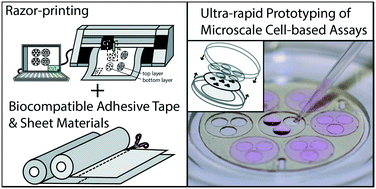Our official English website, www.x-mol.net, welcomes your
feedback! (Note: you will need to create a separate account there.)
Razor-printed sticker microdevices for cell-based applications†
Lab on a Chip ( IF 6.1 ) Pub Date : 2018-01-03 00:00:00 , DOI: 10.1039/c7lc00724h Loren E Stallcop 1 , Yasmín R Álvarez-García , Ana M Reyes-Ramos , Karla P Ramos-Cruz , Molly M Morgan , Yatao Shi , Lingjun Li , David J Beebe , Maribella Domenech , Jay W Warrick
Lab on a Chip ( IF 6.1 ) Pub Date : 2018-01-03 00:00:00 , DOI: 10.1039/c7lc00724h Loren E Stallcop 1 , Yasmín R Álvarez-García , Ana M Reyes-Ramos , Karla P Ramos-Cruz , Molly M Morgan , Yatao Shi , Lingjun Li , David J Beebe , Maribella Domenech , Jay W Warrick
Affiliation

|
Tape-based razor-printing is a flexible and affordable ultra-rapid prototyping approach for microscale device fabrication. However, integration of this prototyping approach into cell-based assay development has been limited to proof of principle demonstrations. This is in large part due to lack of an established or well-characterized option for biocompatible adhesive tape. Without such an option, integration of these areas will remain unexplored. Therefore, to address this critical hurdle, we characterized microscale devices made using a potentially biocompatible double-sided adhesive, ARCare 90106. We validated tape-based device performance against 96-well plates and PDMS microdevices with respect to cell viability, hydrophobic small molecule sequestration, the potential for leaching compounds, use in fluorescence microscopy, and outgassing (bubble formation). Results supported the tape as a promising tool for future cell-based assay development. Therefore, we subsequently demonstrated specific strengths enabled by the ultra-rapid (<1 h per prototype) and affordable (∼$1200 cutting plotter, <$0.05 per prototype) approach. Specifically, data demonstrate the ability to integrate disparate materials for advanced sticker-device functionality such as bonding of polystyrene devices to glass substrates for microscopy applications, inclusion of membranes, and incorporation of different electrospun biomaterials into a single device. Likewise, the approach allowed rapid adoption by uninitiated users. Overall, this study provides a necessary and unique contribution to the largely separate fields of tape-based razor-printing and cell-based microscale assay development by addressing a critical barrier to widespread integration and adoption while also demonstrating the potential for new and future applications.
中文翻译:

用于基于细胞的应用的剃刀印刷贴纸微型器件†
基于胶带的剃刀打印是一种灵活且经济实惠的超快速原型制作方法,适用于微型器件制造。然而,这种原型方法与基于细胞的检测开发的整合仅限于原理论证证明。这在很大程度上是由于生物相容性胶带缺乏成熟或良好特性的选择。如果没有这样的选择,这些领域的整合将仍未得到探索。因此,为了解决这一关键障碍,我们对使用潜在生物相容性双面胶 ARCare 90106 制成的微型设备进行了表征。我们针对 96 孔板和 PDMS 微型设备在细胞活力、疏水性小分子隔离方面验证了基于胶带的设备性能、浸出化合物的潜力、在荧光显微镜中的使用以及除气(气泡形成)。结果支持该磁带作为未来基于细胞的检测开发的有前途的工具。因此,我们随后展示了超快速(每个原型 <1 小时)和经济实惠(约 1200 美元的刻字机,每个原型 <0.05 美元)方法所带来的特定优势。具体来说,数据证明了集成不同材料以实现先进的贴纸设备功能的能力,例如将聚苯乙烯设备粘合到用于显微镜应用的玻璃基板、包含膜以及将不同的电纺生物材料合并到单个设备中。同样,该方法也允许外行用户快速采用。 总体而言,这项研究通过解决广泛集成和采用的关键障碍,同时也展示了新的和未来应用的潜力,为基于胶带的剃刀打印和基于细胞的微量测定开发这两个很大程度上独立的领域提供了必要且独特的贡献。
更新日期:2018-01-03
中文翻译:

用于基于细胞的应用的剃刀印刷贴纸微型器件†
基于胶带的剃刀打印是一种灵活且经济实惠的超快速原型制作方法,适用于微型器件制造。然而,这种原型方法与基于细胞的检测开发的整合仅限于原理论证证明。这在很大程度上是由于生物相容性胶带缺乏成熟或良好特性的选择。如果没有这样的选择,这些领域的整合将仍未得到探索。因此,为了解决这一关键障碍,我们对使用潜在生物相容性双面胶 ARCare 90106 制成的微型设备进行了表征。我们针对 96 孔板和 PDMS 微型设备在细胞活力、疏水性小分子隔离方面验证了基于胶带的设备性能、浸出化合物的潜力、在荧光显微镜中的使用以及除气(气泡形成)。结果支持该磁带作为未来基于细胞的检测开发的有前途的工具。因此,我们随后展示了超快速(每个原型 <1 小时)和经济实惠(约 1200 美元的刻字机,每个原型 <0.05 美元)方法所带来的特定优势。具体来说,数据证明了集成不同材料以实现先进的贴纸设备功能的能力,例如将聚苯乙烯设备粘合到用于显微镜应用的玻璃基板、包含膜以及将不同的电纺生物材料合并到单个设备中。同样,该方法也允许外行用户快速采用。 总体而言,这项研究通过解决广泛集成和采用的关键障碍,同时也展示了新的和未来应用的潜力,为基于胶带的剃刀打印和基于细胞的微量测定开发这两个很大程度上独立的领域提供了必要且独特的贡献。











































 京公网安备 11010802027423号
京公网安备 11010802027423号